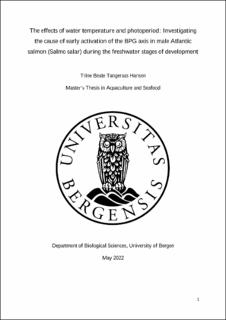| dc.description.abstract | Early sexual maturation of Atlantic salmon (Salmo salar) post-smolts has been a major issue over the years and has recently become a prevalent issue in land-based production systems like the recirculating aquaculture systems (RAS), where early maturation is more prevalent in males. Atlantic salmon that mature early experience a loss of growth, may have a higher risk of infections and are at risk of dying if they are kept in sea water during maturation, and the aquaculture companies experience a loss of profit and altered production schedules. Male Atlantic salmon were exposed to two different temperatures regimes of 12.5℃ and 15℃ and photoperiod regimes, where all salmon were exposed to long light, LL (LD 24:0) prior half being exposed to a winter signal period, WS for 5 weeks (LD: 12:12) and then LL. Body weight and condition factor (K) was measured and calculated to examine changes in growth and the gonadosomatic index (GSI) was calculated to discern maturation levels in the four experimental groups (12.5℃-WS, 12.5℃-LL, 15℃-LL and 15℃ WS). Gene expression profiles were calculated as relative mRNA abundance, where diencephalon expressions of gnrh2, gpr54, gniha, gnihb, and dio2b and pituitary tshβb expression were analyzed to ascertain their potential influence on maturation. The salmon in all experimental groups grew steadily throughout the experiment, and condition factor mainly increased in all groups suggesting the salmon did not smoltify normally. Early maturation was observed in the 15℃-LL group, indicating that exposure to a higher water temperature and continuous light may trigger early onset maturation in Atlantic salmon. Temperature was the key factor influencing changes in diencephalon expression of gnrh2, gpr54, gniha and gnihb over time, where a possible effect of the onset of maturation may be stimulated by exposure to LL and inhibited by exposure to WS. Photoperiod was the key regulator on the pituitary expression levels tshβb, which increased in only the 15℃-WS group and 12.5℃-WS group following exposure to LL. Results indicate that there is a TSH-DIO2 signaling system in Atlantic salmon, but its role related to maturation is not as clear as in mammals and birds. The lack of a tshβb expression peak in the salmon exposed to continuous lights suggest that this light regime disrupts the physiology during freshwater development and emphasizes the importance of subjecting salmon to a winter signal during freshwater development. Further studies are needed to elucidate the possible role of TSH in smoltification and maturation in Atlantic salmon. Of the tested photoperiod and temperature regimes, exposure to a water temperature of 12.5℃ and a winter signal period presents as the best option to avoid early post-smolt maturation in Atlantic salmon. | |
